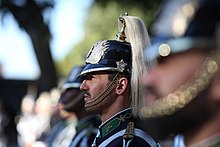National Republican Guard (Portugal)
At national level, GNR also has duties of customs enforcement, coastal control, nature protection, search and rescue operations and state ceremonial guards of honor.In 2006, the multinational consulting company Accenture made a study, requested by the Government of Portugal, that recommended the change of the organization of the Portuguese security forces, including a radical reorganization of the GNR.The National Republican Guard now includes the following: Source:[9] Reporting directly to the Commandant-General are the following: The old four-brigade structure was replaced by a system of territorial commands, each covering a district or an autonomous region.The territorial commands of the Azores and Madeira play, essentially, just a coastal monitoring and fiscal actions, respectively, under the functional dependence of the UCC and UAF.The Municipal Guard was considered part of the Army, but was dependent on the Ministry of Internal Affairs for all matters regarding public security.In 1911, the Republican Guard was transformed in the National Republican Guard (GNR): this was to be a security force consisting of military personnel organised in a special corps of troops depending, in peace time, on the Ministry of Internal Administration, for the purpose of conscription, administration and execution with regards to its mission, and the Ministry of the National Defense for the purpose of uniformization and normalization of the military doctrine, as well as for its armament and equipment.















PortugalGendarmerieLisbonMinistry of the Internal AdministrationMinistry of National DefenceAngolaUNAVEM IIIEast-TimorUNTAETUNMISETUNOTILDR CongoIRAQ FREEDOMRepublic of North MacedoniaOSCE SkopjeLiberiaIvory CoastUNSTAMIHPalestineBosniaEUFOR AltheaEUROGENDFORKosovoGeorgiaEUMM GeorgiaOrder of the Tower and SwordOrder of ChristOrder of AvizOrder of Prince HenryOrder of Timor-LesteOrder of LibertyPortuguesePublic Security Police (PSP)preventive policehighway patrolEast TimortheatresTimor-LestePresidencial Palace of BelémCosta da CaparicaMinistry of Internal AdministrationArmed Forces General StaffFiscalTraffic Brigadesmilitary field divisionmilitary-type staffAccentureGovernment of Portugalgeneral officerCommandant-GeneralAzoresAveiroBragançaCastelo BrancoCoimbraÉvoraGuardaLeiriaMadeiraPortalegreSantarémSetúbalViana do CasteloVila Realcoast guardrear-admiralSecurity and State Honor UnitBanda da Guardatactical operationsPrince Regent JohnPina Maniquetransfer of the Portuguese Court to Rio de Janeiroinvasion of Portugal by the Napoleonic forces in 1807Royal Guard of the Police of Rio de Janeiromilitary policeBrazilCivil WarPeter IVQueen Mary II5 October 1910 revolutionGuarda FiscalItalianMultinational Specialized UnitOrder of the Tower and of the Sword, of Valour, Loyalty and MeritRepublican Revolt 31 January 1891NATO codeVolkswagen PassatNissan AlmeraMercedes-Benz SprinterNissan PatrolMitsubishi PajeroMitsubishi L200Mitsubishi OutlanderŠkoda OctaviaLand Rover Defender9×19mmTaser X26Glock 19AustriaGlock 17Heckler & Koch USP CompactGermanySIG Sauer SP 2022Walther P99Desert EagleIsrael.357 MagnumHeckler & Koch MP5Heckler & Koch MP7HK UMP45Brügger & Thomet MP9SwitzerlandFabarm SDASS TacticalBenelli M3Benelli M4H&K G3A3HK G36H&K 416A5H&K 417A2H&K G28Brügger & Thomet APRMSG-90Accuracy International AW50Heckler & Koch MG4FN MAGBelgium

